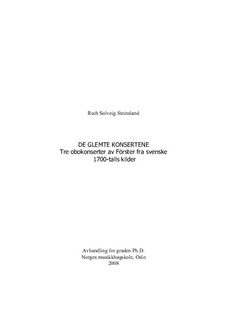| dc.description.abstract | The basic material of the present project, are 91 manuscripts of oboe-concertos from the University-libraries of Lund and Uppsala and from the Statens Musiksamlingar in Stockholm, Sweden. Three oboe-concertos attributed to Förster have been chosen for closer attention. These three Förster-concertos are investigated in two ways in the project. Firstly, the 1st movements of the concertos are analysed according to musical figures found in Mattheson, Walther and Scheibes contributions to the Figurenlehre of the 18th Century. Secondly, the oboe-concertos have been investigated through a process of practicing, rehearsing and performing the concertos in public recitals. This musical process is discussed in the treatise. The enclosed audible versions of the concertos (video and recordings) are produced throughout the project. - - - The German baroque-composer Christoph Förster (1693-1745), was highly respected in his own days. He wrote many solo-concertos, and several of these were for the oboe. Most of Förster’s oboe-concertos exist today in Swedish 18th Century sources only. In fact, a lot of oboe-repertoire from the European musical centres found its way to Sweden in the 18th Century. One reason for this is that highly educated continental oboists did their service in Sweden, as court-musicians or military musicians, since Sweden was an important empire in the 17th and 18th Century. With these learned musicians there also came great repertoire. Sweden has not been in war since the death of Carl XII in 1718, and the environment for safe keeping of musical repertoire has been very good in this country. In contrast, a lot of repertoire in Germany has been destroyed or lost, because of turbulent political situations. It is not a coincidence that a vast part of the 18th Century oboe-repertoire in Swedish libraries has its origin from Dresden and Berlin, important musical centres in the 18th century, which were horribly damaged in the Second World War. As a matter of fact, the well kept manuscripts from the 18th century in Sweden, represents an important source to music from the 18th Century Germany. - - - The three selected oboe-concertos are the concerto in d-minor (S-skma Ob-R), the concerto in e-minor (S-L Wenster D:24) and the concerto in Eb-major (S-L Kraus 228). The d-minor- and the e-minor-concertos are of high quality: All the three movements have a convincing form. In the outer movements the tutti- and solo-sections are apparent. The musical structure of the 1st movements makes evident a close knowledge to the musical Figurenlehre. Inventive melodies with clear directions are characteristic for the two concertos. The Eb-major-concerto also follows the standard three-movement form. It has a beautiful 2nd movement, where the two against three-pattern in the accompaniment is quite extraordinary. There are also some very nice spots in the 1st and 3rd movement, but the lack of clear tutti- and solo-sections as well as too little substantial musical material for the length of the movements, put this concerto on a lower level. The attribution of this concerto is uncertain since it is attributed to “Hendell” in the source, and to “Foerster” in the Breitkopf Thematical Catalogue (1762-1787). - - - Sources of more than 10 oboe-concertos attributed to Förster are available today, in addition to the three which are studied in the present project. To give new life to the oboe-concertos by this clever but little known composer, should be of current interest for the contemporary music-scene. | en_US |
